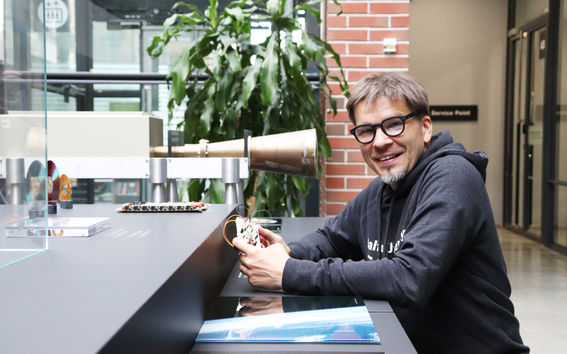What does a Doctor of Arts do at the School of Electrical Engineering?

Salu Ylirisku, Doctor of Arts, teaches design process and related skills to aspiring engineers at the School of Electrical Engineering. The introduction of design tuition to an engineering department has aroused interest and curiosity. A typical misconception that Ylirisku regularly finds himself correcting is confusing art with design:
‘Art is a broader concept than design, and it doesn’t encompass an obligation to produce something of use. Designers, on the other hand, work in a goal-oriented manner to design products, systems and services that function in contexts that people operate in and generate the benefits they were intended to.’
At the School of Electrical Engineering, students have traditionally been taught special skills, such as control theory, simulation and design of technical systems and devices. Mathematical thinking and scientific command of physical phenomena have typically been emphasised in the tuition. Engineering problems are solved by breaking them into smaller pieces that are easier to solve, and these pieces are then put together to form the complete solution.
In contrast, the design process involves more than shaping physical material into an appropriate form.
‘It’s a social process. Design solutions primarily function at the level of meanings and experiences, which has to be taken into account in the concrete realisation. Because of this, in addition to knowledge of materials and related work processes, designers are taught observation, interpretation and reasoning. Having such skills benefits technical experts too.’
Both technical and human aspects must be taken into account in the design process
Often, when design is combined with engineering, bridges must be built between different ways of thinking. For example, in the design of a new IoT device, several factors influencing user experience must be factored in: the user’s actions and the situation in which the device is used and the reliability and efficacy of the device’s operations – will the battery run out after a couple of hours or can the device be used for decades without recharging?
‘In an expert project, it is not unheard of to use up to six months to design and realise a technically brilliant solution that proves useless because users’ needs haven’t been taken into account. On the other hand, in design projects, ideas may be mulled over for months without the work resulting in a functional technical solution.’
Ylirisku’s goal is to improve engineers’ ability to work in interaction with designers. This will enable more efficient use of project resources.
Students have been quick to realise the benefits design can bring to an engineering project.
‘Design tuition has received an enthusiastic welcome from students. And I’m inspired by their enthusiasm!’
Read more news
From coffee rooms to big crowds – Discussion is important in developing new lifewide learning content in Aalto
Craig Carlson is developing educational content for the target audience of lifewide learning, such as adult learners in working life.
Pengxin Wang: The internship was an adventure filled with incredible research, unforgettable experiences, and lifelong friendships.
Pengxin Wang’s AScI internship advanced AI research, fostered global friendships, and inspired his journey toward trustworthy AI solutions.
Major grant from the Kone Foundation for modern architecture research - Laura Berger's project equates building loss with biodiversity loss
Aalto University postdoctoral researcher Laura Berger and her team have been awarded a 541 400 euro grant from the Kone Foundation to study the effects of building loss on society and the environment.